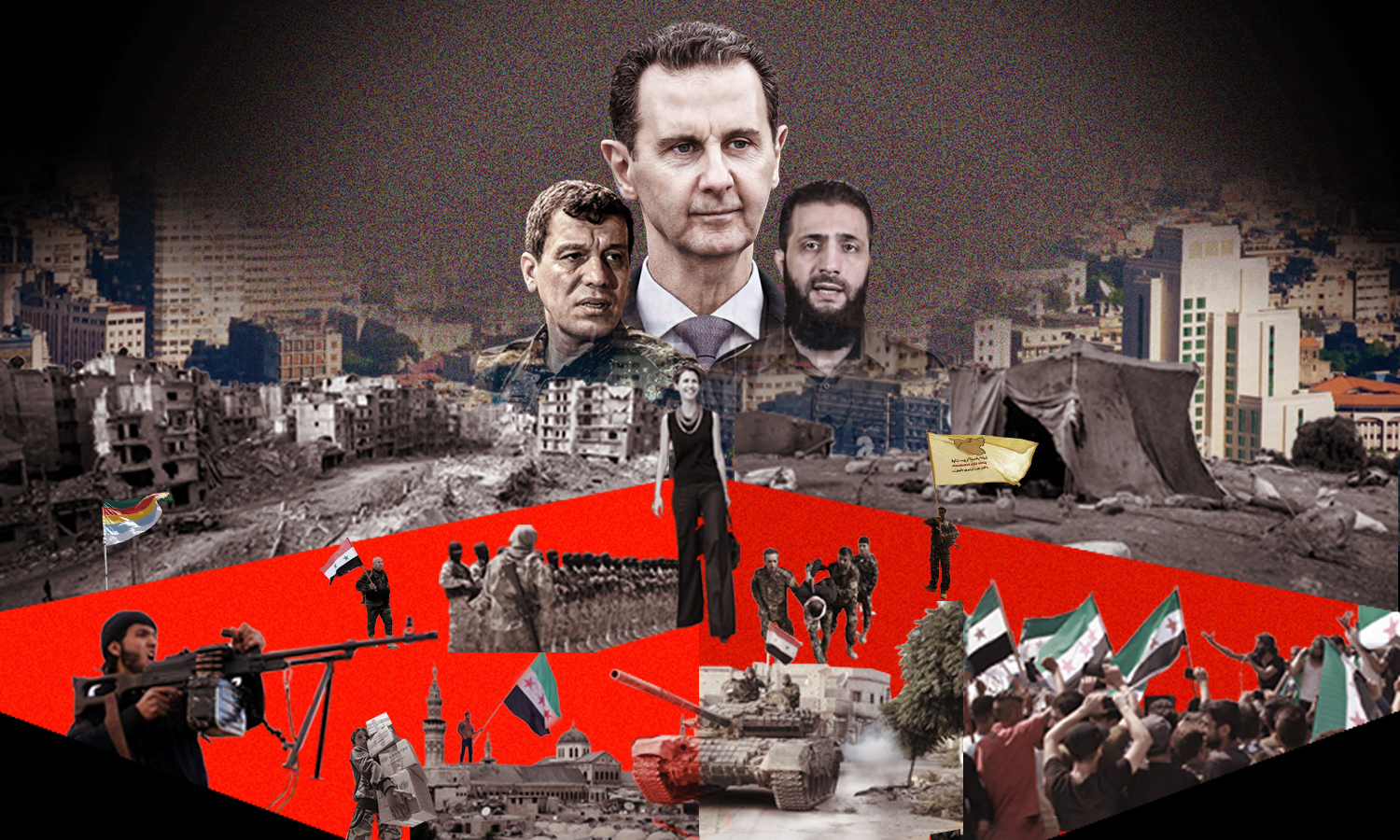


(Edited by Enab Baladi)


Khaled al-Jeratli | Muhammed Fansa | Hussam al-Mahmoud
The year 2023 was marked by political upheavals on the Syrian front, as it brought about a convergence between Turkey and the regime, followed by a normalization of relations between the latter and the Kingdom of Saudi Arabia.
The developments extended beyond the political realm, witnessing shifts in the security landscape, casting shadows over areas of influence in northeastern and northwestern Syria, as well as the south.
While Syria’s economy has always been influenced by its political and security dynamics, the improvement in the political landscape for the regime did not significantly impact the Syrians’ economy, with its effects merely reflected in the official Syrian media reports.
In this lengthy article, Enab Baladi discusses with specialized experts and researchers the key events that dominated the Syrian scene during 2023, along with their implications for 2024.
The onset of 2023 saw significant political changes unfolding on both the regional and international levels, catalyzed by the seismic wave of February 6, which was followed by Arab movements that had long been blocked to the Syrian regime. Subsequently, this led to an expanded political space, distinct from the economic turmoil within the country, which sparked ongoing protests in the south, highlighting the lack of coherence between these levels.
These developments continued since the beginning of the year, following the inception of a rapprochement process between Turkey and the Syrian regime in 2022, initially materializing through ministerial and intelligence-level meetings. However, this process ground to a halt on the diplomatic front in mid-2023, due to mutual conditions set by both Ankara and Damascus, distancing Bashar al-Assad from meeting the Turkish President on a unified platform and restoring the relationship to the box of conditions from which the political moves began with Moscow’s endeavors and subsequent participation from Tehran.
In this context, the international relations researcher Mahmoud Aloush opines that the factors surrounding the Turkish dialogue with the regime, whether concerning Turkey’s military presence in Syria or the regional and international interactions regarding Syrian affairs, do not suggest a genuine breakthrough in the dialogue between the two parties in 2024.
Considering the prospect of potential agreements on certain matters, Aloush believes that tangible results leading to a shift in this context are improbable. However, 2024 is expected to witness significant events in the dialogue between Turkey and the regime, including the future of the US military presence in Syria, contingent on the outcome of the US presidential elections. The potential return of former US President Donald Trump to the White House might have substantial implications on the situation in Syria and the Turkish dialogue with the regime, given that Turkey’s motivation for this dialogue includes pressuring Washington to reduce its ties with the Kurdish units in northeastern Syria.
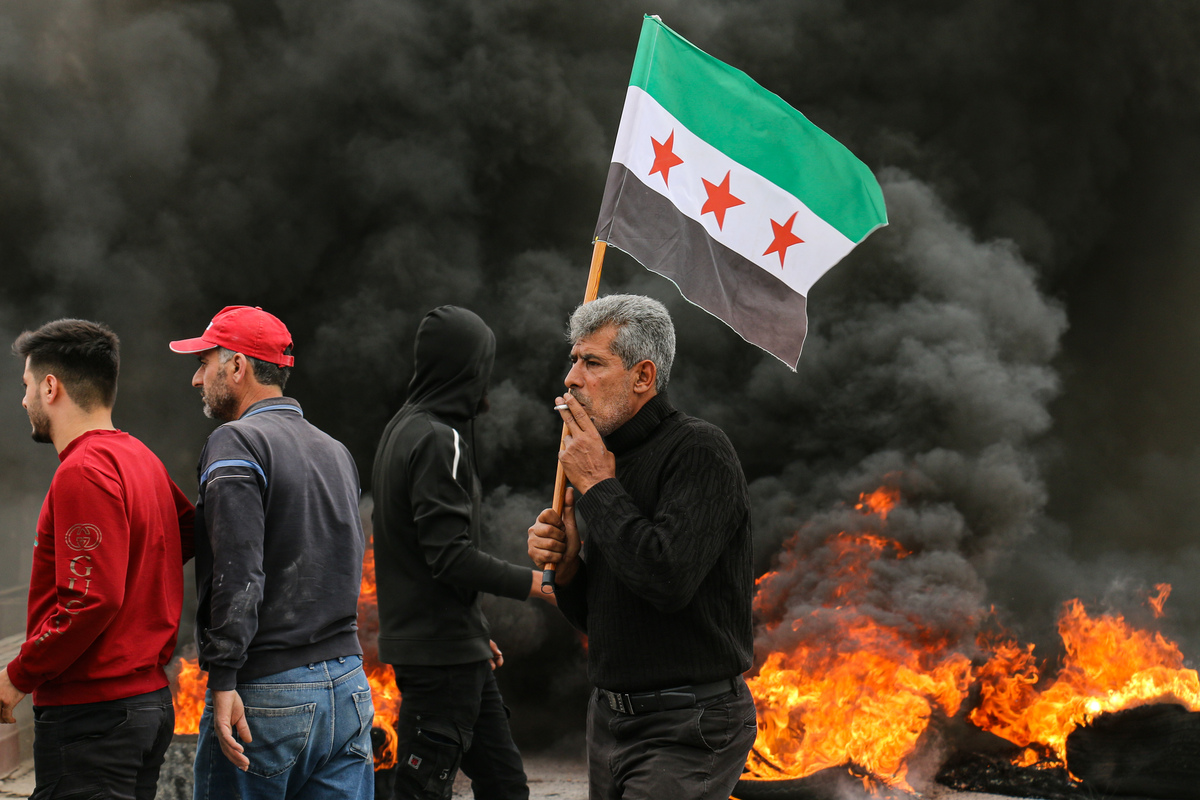
A man carries the flag of the Syrian revolution in the city of Azaz denouncing the attempt of Hayat Tahrir al-Sham to enter it – October 16, 2023 (Enab Baladi/Dayan Junpaz)
Following the rapid Arab rapprochement after the Feb. 6 earthquake in Turkey and Syria, the regime managed to reclaim Syria’s seat in the Arab League, with Bashar al-Assad’s participation in the Arab Summit in Jeddah, marking his first attendance since the 2010 summit in Sirte, Libya.
Moreover, this wave opened the doors to official visits, as al-Assad received the Egyptian, Jordanian, and Saudi Foreign Ministers in Damascus in February. This was coupled with a shift in political sentiment towards dealing with the regime, particularly evident in the Arab-backed “Jordanian Initiative,” enabling Arab negotiations with the regime from a Jordanian perspective. However, these negotiations faced obstacles, including drug trafficking, directly affecting Saudi Arabia and Jordan, which led to setbacks in the process.
Despite the repercussions on Saudi Arabia, it continued its rapprochement with the regime, culminating in the accreditation of Ayman Soussan as Syria’s ambassador to the kingdom on December 25, after he was sworn in before al-Assad on December 6.
Following the paths taken by Arab states to Damascus, the Arab Ministerial Liaison Committee was formed to monitor the implementation of the agreements reached with the regime in previous ministerial meetings in Amman and Jeddah. The committee held a solitary meeting in Cairo, with no new developments in the final statement, except for an agreement to hold the next meeting in Baghdad, which did not materialize due to Western pressures on the committee, in order to avoid more concessions to the regime.
Nader al-Khalil, a researcher at the Omran Center for Strategic Studies, believes that the regime failed to achieve its desired convergence with the Arabs, specifically Saudi Arabia. It was expected that the regime would meet certain conditions to advance the rapprochement process, but it remains obstinate and unwilling to make the necessary concessions.
Regarding the exchange of embassies, al-Khalil views it as largely symbolic and having little significant impact, as the UAE preceded Saudi Arabia in this move by opening its embassy in Damascus in 2018, however this move did not have a profound political impact on the normalization processes with the regime, according to the researcher.
According to al-Khalil, with the current circumstances remaining stable and the regime’s inability or reluctance to make required concessions in the drug trafficking and containment of Iranian influence, along with improving the political and security environment to allow for the return of refugees, achieving a real development in the rapprochement is unlikely. Under these circumstances, the process may take a reverse direction, especially with the increasing attempts to smuggle drugs into Jordan and the escalating Jordanian military response to such activities.
Al-Assad’s foreign visits in 2023 included two to Saudi Arabia, one to Oman, and another to the UAE, along with a visit to Russia. These visits seemed to overlook the lingering political tracks for resolving the Syrian file and international efforts to bridge the gap between the Syrian opposition and the regime.
The Astana track closed its doors in mid-2023, after 20 rounds of talks, followed by a solitary meeting held last September, assembling the foreign ministers of the Astana group countries (Turkey, Russia, Iran) and the UN Special Envoy to Syria, Geir Pedersen, on the sidelines of the UN General Assembly meetings.
The previous rounds of the Astana meetings witnessed the participation of three countries, two of which are staunch allies of the Syrian regime politically, militarily, and economically (Russia and Iran), with efforts to open up politically with a third (Turkey) since the end of 2022.
However, the recent meeting in New York did not specify the timing or location of the next meeting for the group concerned with discussing the Syrian file, in order to reach a solution that has been under discussion for nearly 13 years without any substantial progress.
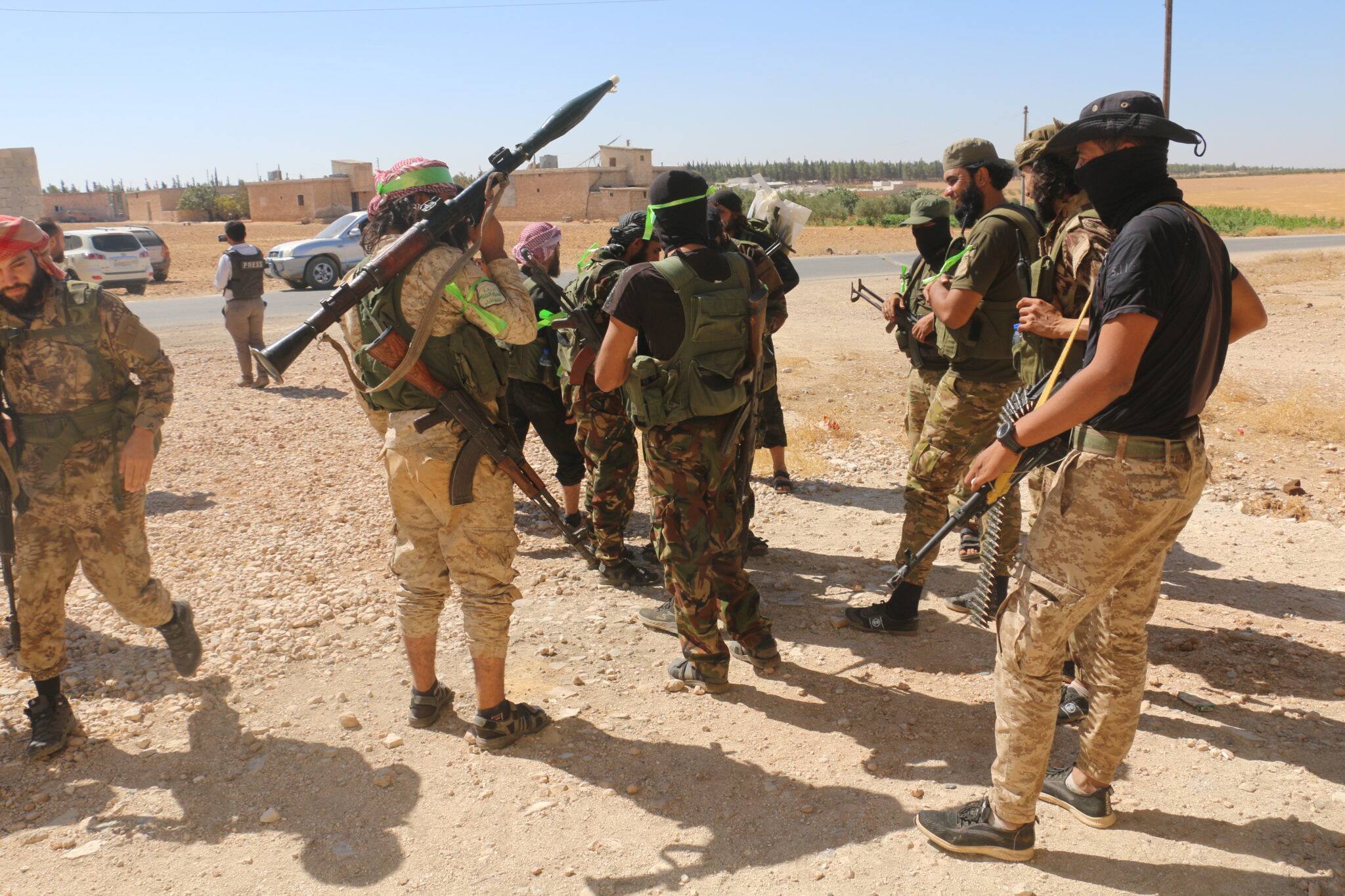
Clan fighters prepare to attack villages in rural Manbij, east of Aleppo, where the Syrian Democratic Forces are in control – September 6, 2023 (Enab Baladi/Dayan Junpaz)
During 2023, four security files dominated the scene in Syria, with the latest being the internal conflict at the top of the Hayat Tahrir al-Sham (HTS) hierarchy in December, preceded by a tribal uprising in eastern Syria, specifically in Deir Ezzor governorate, with continuous ramifications to date.
The developments extended to southern Syria, which witnessed peaceful uprisings against the regime in the As-Suwayda governorate, leaving options open amidst the regime’s security absence and near-complete control of local factions.
The issue of drug smuggling from Syria to Jordan, which the Syrian regime is accused of being involved in along with Iran-affiliated militias, loomed over the forefront consistently but peaked recently when small yet frequent smuggling attempts escalated into an armed attempt to breach the Jordanian border.
The General Security Service affiliated with Tahrir al-Sham, which controls Idlib governorate and parts of the countryside of Hama, Aleppo, and Latakia, published images from a security campaign it launched to pursue individuals described as “regime collaborators.”
This campaign was initiated following circulating discussions of a breach within Tahrir al-Sham, which was announced by the General Security Service in June, where the spokesman for the Security Service said it was from “new recruits.”
The General Security Service stated on December 27, that the campaign is part of its efforts to pursue a “spy cell” working for the regime and its allies within the areas under Tahrir al-Sham.
The issue took a different turn when Tahrir al-Sham detained leaders of its top-ranking members and chased after Jihad Issa al-Sheikh (Abu Ahmad Zakour), who managed to escape to areas under the control of the Turkey-backed Syria National Army (SNA) in northern Aleppo province.
On December 18, Tahrir al-Sham announced the removal of the prominent leader Jihad Issa al-Sheikh from the faction due to “misuse of his position and violation of the general policy.”
Al-Sheikh, who later declared his defection from Tahrir al-Sham, clarified to Enab Baladi that the charges against him of “misuse of his position, violation of the general policy, financial corruption, blackmail, and security suspicions” were unfounded.
These developments were preceded last August by the announcement of Tahrir al-Sham of freezing the powers and functions of the member of the Shura and Leadership Council in the first row, Abu Maria al-Qahtani, due to his “mismanagement of his communications without regard to the sensitivity of his position.”
Tahrir al-Sham said that it had frozen the powers and functions of Abu Maria al-Qahtani after having his name in some investigations conducted by it regarding “collaborating with the regime”.
Tahrir al-Sham stated that it had questioned him in full transparency and clarity to avoid suspicion and remove confusion and that the investigative committee found that al-Qahtani had mismanaged his communications without regard to the sensitivity of his position or the need for permission and clarification of the intended communication.
These developments within the body of Tahrir al-Sham, which seem unlikely to conclude soon, could take two scenarios in the near and medium term, according to Orabi Orabi, a researcher in jihadist groups’ affairs.
The first scenario involves Tahrir al-Sham expanding, absorbing the shock caused by the defections within its ranks, and coordinating with factions in the National Army, comprising three brigades in northern Aleppo, to form an alliance or a single bloc, operating under a new name, distant from the name of “Hayat Tahrir al-Sham.”
The second scenario entails Tahrir al-Sham remaining in its current form alongside enhancing its relations with factions in the National Army, while groups that defected from it, particularly Jihad Issa al-Sheikh, work on forming a military bloc as a counterbalance to Tahrir al-Sham.
Orabi noted that al-Sheikh or “Abu Ahmad Zakour” is considered the person responsible for external relations within Tahrir al-Sham during his tenure. Consequently, he will strive to establish a network of relationships to bolster the National Army, and push for the accession of the National Liberation Front (active in Idlib and its countryside) to the Syrian National Army as a fourth corps, at the expense of Tahrir al-Sham.
The researcher emphasized that the potential changes that could occur over the year 2024 may generate additional indicators that render the scene more transparent.
Between August and September last year, armed clashes broke out between the Syrian Democratic Forces (SDF) and the Deir Ezzor Military Council affiliated with them, following the arrest of the latter’s leader, Ahmad al-Khabeel (known as Abu Khawla).
While the SDF attempted to portray the issue as just a new security campaign it was conducting in the region against the Islamic State organization, it turned into confrontations between the SDF and Arab tribes that formed an alliance among themselves, seizing villages and towns in eastern Deir Ezzor.
Later, the SDF managed to regain control of the entire area, and proposed restructuring the Deir Ezzor Military Council, while groups from the region’s tribes continued to launch intermittent and geographically scattered attacks on its military points in the area.
It quickly became evident that the Syrian regime, based west of the Euphrates River, supported these tribal movements, as it supervised providing cover fire in one of the attacks for the tribal groups, led to this day by Sheikh Ibrahim al-Hafel, a leader of the Bakir tribe.
Against the backdrop of the confrontations in which the US-led International Coalition intervened, the commander of the SDF, Mazloum Abdi, proposed a plan for “reforms“, then the Autonomous Administration came out with a set of items to present “reforms”, and then the Syrian Democratic Council (MSD) elected Mahmoud al-Maslut as its co-chair, appearing to be a reinforcement for the Arab component in northeastern Syria during the upcoming phase.
Anas Shawakh, a specialized researcher in northeastern Syrian affairs at the Jusoor for Studies Center, told Enab Baladi that there are no clear indications so far of potential changes to resolve the Arab grievances in the areas under the SDF’s predominantly Kurdish control.
He added that Mahmoud al-Maslut came to his current position, leading the MSD, succeeding Riyad Adar, who is also an Arab, but his influence was not noticeable during the past period, while the role of Ilham Ahmad, a former member of the Kurdistan Workers’ Party (PKK) accused of dominating the decision-making mechanisms of the SDF.
Shawakh said that Riyad Adar was not only an Arab, but he also came from the Deir Ezzor province, which has witnessed the largest share of Arab representation problems and grievances in the past years.
The researcher ruled out that the appearance of al-Maslut in the MSD would have any impact on the level of Arab representation of the region’s administration.
Shawakh believes that the problem of the Arab component in Deir Ezzor, in particular, is caused by the structure of governance and administration in northeastern Syria in terms of politics, services, security, and military, and as long as this structure does not change, there is no intention to solve the problem for the SDF.
Regarding the activities of the tribal fighters led by Sheikh Ibrahim al-Hafel, Anas Shawakh sees that the lack of supplies and resources will lead to a diminishing of their movements in eastern Deir Ezzor in the near and medium term.
The state of tension will not change unless the SDF addresses fundamentally the Arab grievances in the region.
Anas Shawakh, Researcher at Jusoor for Studies Center
Amid the waning status of the Syrian file and its descent from the top priorities of the international community to lower ranks, the people of As-Suwayda province took to the streets in August last year calling for the overthrow of the Syrian regime and the implementation of UN Security Council Resolution 2254, which calls for achieving a peaceful transfer of power.
After nearly five months since the start of the first demonstration, the regime continues to ignore the protesters’ demands, and the living and service conditions remain deteriorated in the province, while media outlets loyal to the regime continue to accuse the movement in As-Suwayda of carrying a “separatist” agenda.
The protesters in As-Suwayda responded to these accusations with banners and slogans, denying the accusations and affirming that the unity of Syrian territory is one of their demands.
Syrian journalist Salem Nasseif, who hails from As-Suwayda, told Enab Baladi that the regime will continue to ignore the peaceful movement taking place in As-Suwayda in the near and medium term, in an attempt to deny the existence of any protests that contradict its presence in power.
The regime will continue to neglect the demands of the province’s residents and relies on the end of protests in the winter season, as the governorate struggles to secure heating resources, due to the deteriorating living conditions, a situation similar to that in other Syrian provinces.
As-Suwayda has been left alone in its movement, knowing that it relied on other provinces to support its peaceful steps, but it did not receive any noticeable support.
Salem Nasseif, Journalist from As-Suwayda province
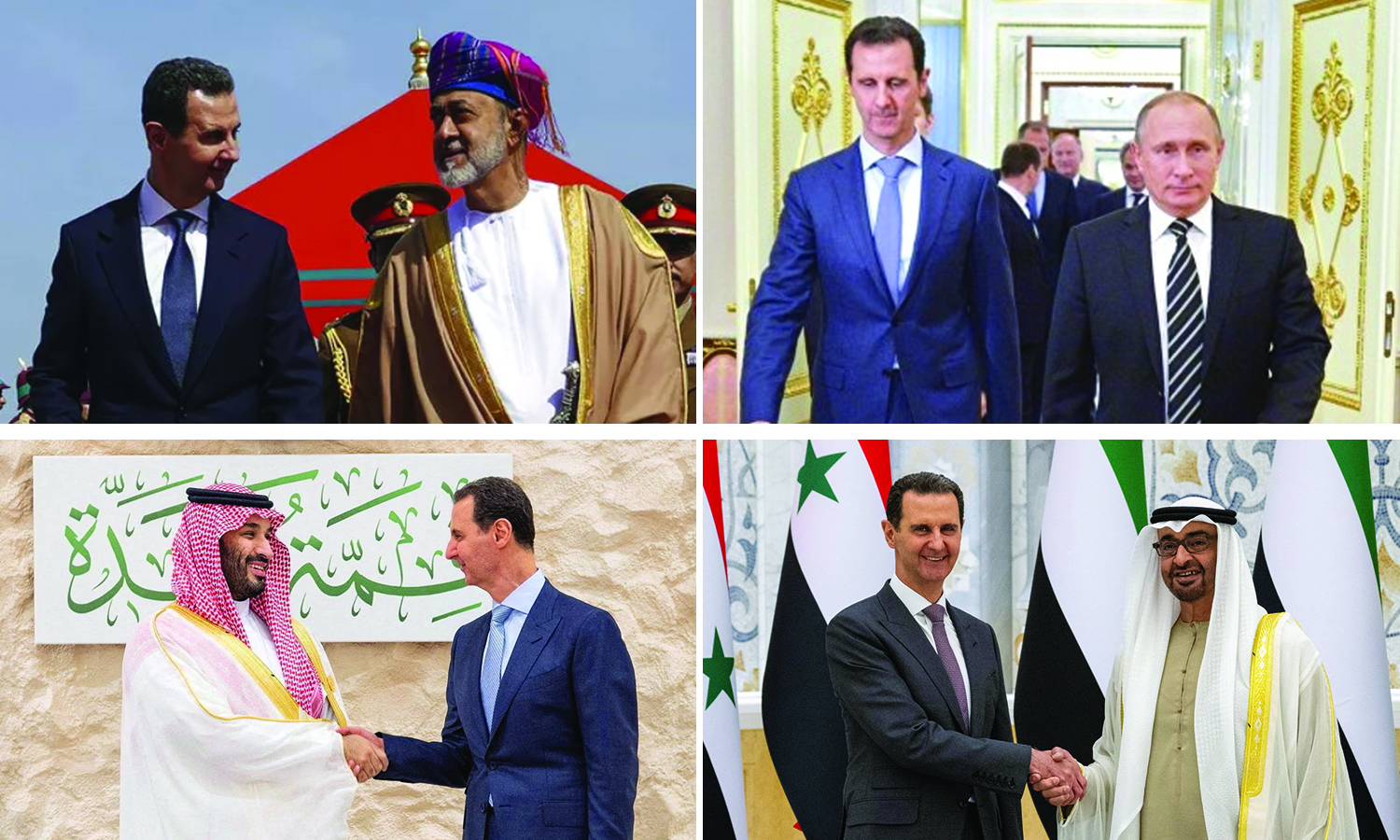
Visits of the Syrian regime president during 2023 to Saudi Arabia, the UAE, Oman, and Russia (Edited by Enab Baladi)
The Syrian-Jordanian borders witnessed during the current year smuggling operations of drugs and weapons towards Jordan, reaching their peak in the last month of 2023, as it turned from occasional smuggling operations in terms of time and geography to attempts to breach the borders with the force of arms through clashes with the Jordanian army.
The shift in operations in the area manifested in armed clashes between the Jordanian army and smugglers on December 19, lasting for 14 hours, during which a Jordanian soldier was killed, in addition to several smugglers being killed or injured, and nine of them being arrested, and “large quantities” of drugs, automatic and rocket weapons were seized, according to the Jordanian TV channel Al-Mamlaka.
To curb these operations, the Jordanian General Security Directorate announced the start of a comprehensive security operation in the Ruwaished area (northeastern Jordan) to pursue drug traffickers and dealers affiliated with regional gangs operating across the borders to smuggle drugs and weapons.
Following the confrontations on the Syrian-Jordanian borders, combat planes, believed to be Jordanian, carried out air raids in southern Syria, targeting “hideouts” of drug traffickers in response to a “large” smuggling operation coming from Syria, according to Reuters, citing unnamed regional intelligence sources.
The planes bombed a house suspected to belong to a prominent drug dealer in the town of Salkhad in the As-Suwayda province, while other strikes hit “hideouts” in the Daraa province.
Dr. Omar al-Raddad, a Jordanian expert in strategic security, told Enab Baladi that the indications suggest that the security tensions on the borders between Jordan and the militias will continue during 2024.
He attributed the reasons for their continuation to the fact that the decision to escalate them is linked to the strategies of the Iranian leadership and the militias affiliated with it, as well as the strategies of the Syrian regime, due to the financial gains achieved through the drug trade, and another strategy for the Iranian leadership by creating a climate to stir up security chaos in Jordan.
Al-Raddad said that the level of this escalation will remain subject to the possibility of reaching peaceful solutions to the “Syrian crisis”, a scenario that is unlikely in the foreseeable future due to the complexities of the crisis internally, such as the conviction of the Syrian regime that it has achieved a victory, and others regionally related to the Iranian role and its future, and internationally manifested in the conflict between Russia and the West after the Ukraine war, and its repercussions on the Syrian file.
It is undeniable that the economic situation in Syria continues to deteriorate year after year, as it is also undeniable to merchants, industrialists, and workers in Syria that the government’s economic policies lead to the continued inflation and record-breaking figures in the indicators of the economic collapse, such as the value of the pound, gold prices, and fuel every year.
The value of the Syrian pound decreased against the US dollar by a rate that reached 113% on an annual basis during 2023, and by 180% based on the official bulletins issued by the Central Bank of Syria (CBS).
During the current year, the lowest value of the Syrian pound against the dollar was on August 16, reaching 15,500 pounds, just one day after announcing a 100% increase in the monthly salary in the Syrian pound, while the exchange rate exceeded 14,600 pounds at the time of publishing this file, according to the specialized S-P Today website tracking the exchange rates of the Syrian pound against foreign currencies.
As for gold, the selling price of a gram of 21 carat gold rose to 812,000 Syrian pounds in December of last year, while it was 325,000 pounds at the beginning of 2023, according to the Craftsmen Association for Jewelry and Jewelry Manufacturing in Damascus, an increase of around 150%.
The prices of petroleum products also recorded a significant increase during the past year, including both the “subsidized” and free or “unsubsidized” petroleum products, amidst the government’s regulation of the sale of these materials and the significant decrease in the purchasing power of the population.
The increase during 2023 in the price of a liter of “subsidized” gasoline reached 200%, and in the “unsubsidized” gasoline it reached 226%, while the increase in the price of diesel reached 185% in the “subsidized” and 159% in the “unsubsidized”.
The state budget is also one of the most important indicators of the local economy’s status, and it takes a downward trend after the budget of the year 2024 marked the least value since 2011, amounting to 35,550 billion Syrian pounds, while the total deficit in the budget reached 9,404 billion pounds, according to the exchange rate of the dollar at the Central Bank at the time of its issuance (12,600 pounds), equivalent to about 2.82 billion dollars, a decrease in value by 2.66 billion dollars, and by 48% from the budget of the previous year.
Syria topped the list of the most corrupt countries according to the Global Risk organization’s classification for 2023, which specializes in risk management services, being ranked at 196 out of the classified countries.
The classification evaluates the perception of corruption in countries on a scale from zero (very clean) to 100 (highly corrupt), based on the extent of money laundering, fraud, and terrorism financing taking place in the country, according to the website.
According to the American Peace Fund’s fragile countries index, Syria came as the fifth most “fragile” country in 2023, after Yemen, Somalia, South Sudan and Congo, out of a total of 179 countries.
The World Bank and the Asian and African Development Bank issue a coordinated list of fragile countries updated annually since 2015, pertaining to the preparation for the Sustainable Development Agenda for 2030 (17 Sustainable Development Goals), with Syria currently ranking 130 out of 166 countries, in a rating reflecting the extent of its implementation of the rules of sustainable development, a decline from the 129th place last year.
Regarding the working population, Syria ranked 21 out of 117 countries in the Working Poverty Rate Index based on the international poverty line of 1.90 dollars per day, according to the International Labor Organization classification for 2022, which also classified the labor productivity in Syria at 159 out of 189 countries, indicating a weak productivity.
As for the employment rate to the population, Syria ranked 170 out of 190 countries with a rate of 40.1%, according to the latest updates of the International Labor Organization for the year 2023, indicating the emigration of the workforce.
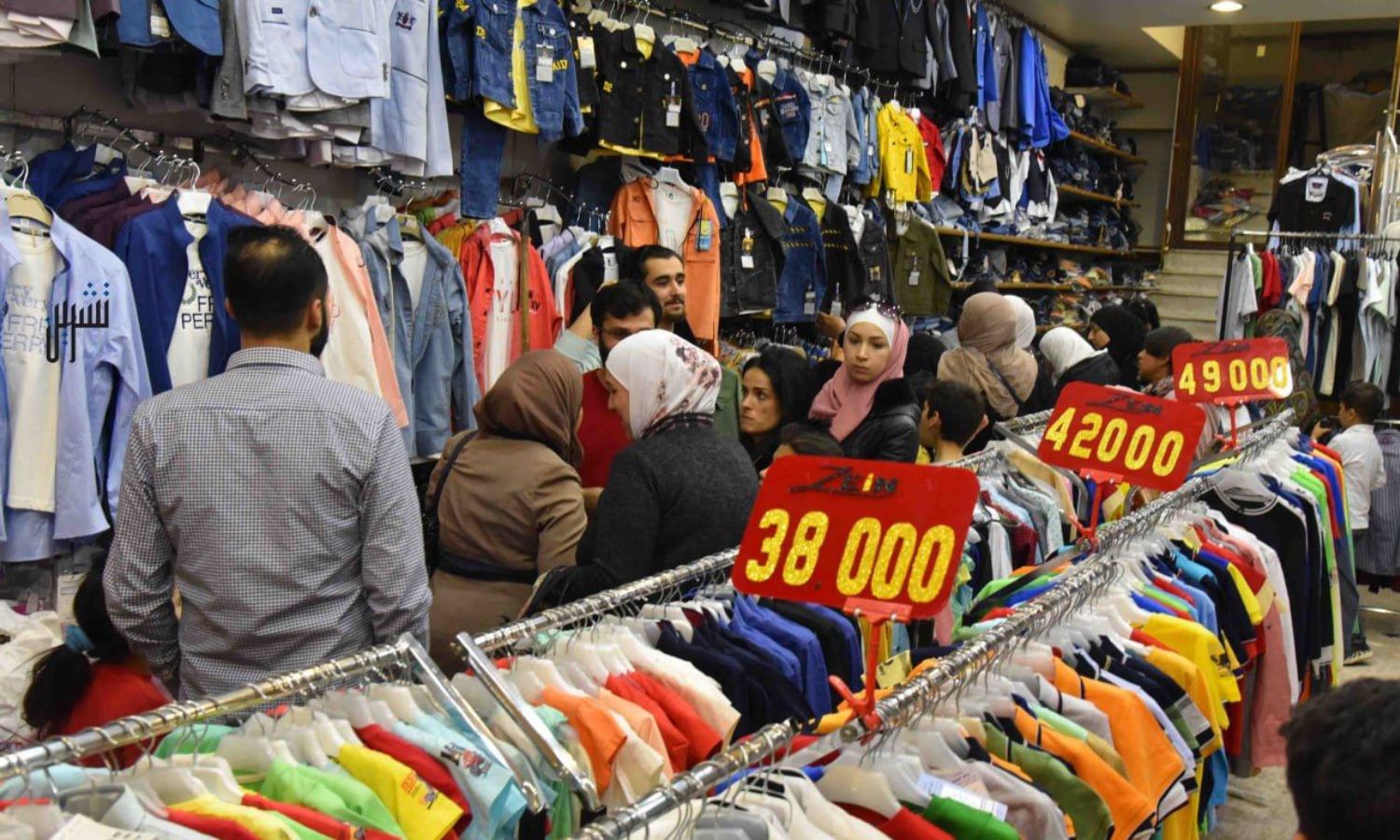
Congestion in a clothing store in the al-Hamidiyah market in the Syrian capital, Damascus – April 15, 2023 (Tishreen newspaper)
During the “Economic Tuesday” seminar of the Economic Sciences Association established by the Syrian Ministry of Social Affairs and Labor in 1965, Dr. Munir al-Hamish, an economist, said at the end of last August that the Syrian economy lost two-thirds of its assets during the war, and lost its most important resources, with its gross domestic product dropping to 20 billion dollars in 2019 after it was 60 billion dollars in 2010.
Regarding the reasons for the deterioration in his opinion, he added that “with the increase of corruption and the influence of connections in administrations and the domination of the warlords, the economy continued to decline and the value of the pound deteriorated.”
Al-Hamish sees the importance of reviewing the economic and social policies to prevent being a cause of “deepening the crisis”.
Dr. Yahya al-Sayed Omar, a political economist, told Enab Baladi that Syria generally, and the areas under the regime’s control in particular, are witnessing “a sharp decline”, and that all international economic indicators are at their lowest limits.
Despite the calmness of the military fronts for several years, and the relative rapprochement between the regime government and some Arab countries, the economy continued to deteriorate, which reinforces the hypothesis that the internal reasons are the most important for the deterioration of the Syrian economy.
Yahya al-Sayed Omar, Political economist researcher
Regarding his reading of the reality of the Syrian economy next year, especially in the areas under the control of the regime, al-Sayed Omar believes that the current reality indicates that the deterioration will remain dominant, and resources will continue to decline, and the control of the regime’s allies over the resources of the Syrian state will not stop, which does not allow any real change in public revenues. In addition, the control of the warlords and their domination of the Syrian economy is increasing significantly, weakening any possibility of an early economic recovery.
The researcher expects an increase in the general budget deficit for the regime’s government next year, a decline in the standard of living, an increase in poverty rates, income deterioration, and a decline in the value of the Syrian pound, especially in light of the scarcity of the dollar supply in the Syrian market.
He also predicted an increase in the activity of the shadow economy and the black market, through an increase in reliance on drug trafficking, especially at the domestic level.
if you think the article contain wrong information or you have additional details Send Correction